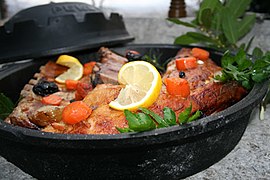
Sač (Cyrillic: Сач; Croatian: Peka) is a large metal or ceramic lid like a shallow bell with which bread dough or various dishes to be baked are covered, and over which ashes and live coals are placed. Dishes prepared in a sač are evenly cooked, retain their juiciness, and are praised for their rich flavour.
Sač can also refer to a dish made of meat, vegetables and potatoes, baked in sač oven.
Origin[edit]
The bell itself probably comes from the saj, a curved metal utensil used on its convex side for flatbread baking, and with the concave side employed similarly to a wok in the Middle East and large parts of Asia.
History[edit]
Traditionally, the sač was a simple, primitive oven for baking various foods used by less well-off families who could not afford a stove in their homes, and the lid itself often doubled as a plate for flatbread baking.
Today, the baking appliance is commonly used by restaurants all over Turkey[dubious ] and the Balkan Peninsula – Bulgaria, Bosnia and Herzegovina, Croatia (where it is called "peka"), Greece (where it is called "Παραδοσιακή Γάστρα", "Σινί" or "Χάνι"), Montenegro, North Macedonia, Serbia, and Slovenia.
Use and characteristics[edit]
Cooking in the sač enables even, convection baking, and the bell shape allows the steam to recirculate, which makes the meat, fish and vegetables to remain juicy, and the potatoes, and vegetables to intermix their flavours with that of the meat. It is also used for baking bread and traditional pastry like burek and pizza. This traditional style of cooking has been adopted mostly because of its specific flavour-enhancing properties, which enable the food to be lightly smoked, additional to aforementioned convection cooking process.
Regional variants[edit]
In Bulgaria, the word сач (sach) or сачѐ (sachè) refers to a flat clay plate, which is heated to a high temperature, and placed on the table, where thin slices of vegetables and meat are cooked on it. Fat is not used, and it is not covered. In the region of the Rhodopes typically more meat is used.
In some regions of Romania, the equivalent of sač, called țest [ro], a derivate of the Latin testum, was used for baking bread.[1][2]
Gallery[edit]
-
An example of cooking lamb in the sač
See also[edit]
References[edit]
- ^ "țest - definiție și paradigmă". DEX online. Archived from the original on 2020-10-20.
- ^ "Țest photos". DuckDuckGo. Archived from the original on 19 August 2020. Retrieved 22 December 2021.





Well, that’s interesting to know that Psilotum nudum are known as whisk ferns. Psilotum nudum is the commoner species of the two. While the P. flaccidum is a rare species and is found in the tropical islands. Both the species are usually epiphytic in habit and grow upon tree ferns. These species may also be terrestrial and grow in humus or in the crevices of the rocks.
View the detailed Guide of Psilotum nudum: Detailed Study Of Psilotum Nudum (Whisk Fern), Classification, Anatomy, Reproduction